All of Europe admired the hussars in their heyday. At some point, however, their fighting spell began to wear out. How did they become "funeral parlors" from arousing riders?
"Hussar banners were not used for other expeditions, but for assistance to some lord's entry to the starosty or voivodeship, or a similar funeral; that is why they called armored hussars funeral soldiers, ”wrote priest Jędrzej Kitowicz about the hussars of the times of Augustus III Saxon (1733–1763). And unfortunately he did not exaggerate. During this period, the hussars were a beautiful formation, but no longer worthwhile from a military point of view. How did it come about? (…)
First symptoms of the crisis
The year is 1619. The Commonwealth has just signed a truce, which interrupted the war with the Grand Duchy of Moscow for several years. The truce favorable to the Commonwealth, which had acquired vast lands, and in addition, the title of the ruler of the Moscow state remained in the hands of the Polish prince (Władysław Vasa). The Republic of the Kingdom of Poland and the Grand Duchy of Lithuania is at its peak. Its area is three and a half times larger than the area of today's Poland. It was closer to Moscow from the eastern border than from Poznań or Kraków to Warsaw.
In the same year, the Polish king Zygmunt III Vasa aids the Austrian emperor by sending him 8,000 cavalry with the help of which in the battle of Humienno crashes the rebellious Hungarian army. Much later it was called Vienna's First Relief.
And who in these moments of triumph could find the crisis of the Polish army? And yet. In 1620, an army of about 10,000, consisting of about 2,500 hussars, commanded by Hetman Stanisław Żółkiewski, the winner of the Battle of Krušin, suffered a devastating defeat in Wallachia (today called Moldavia).
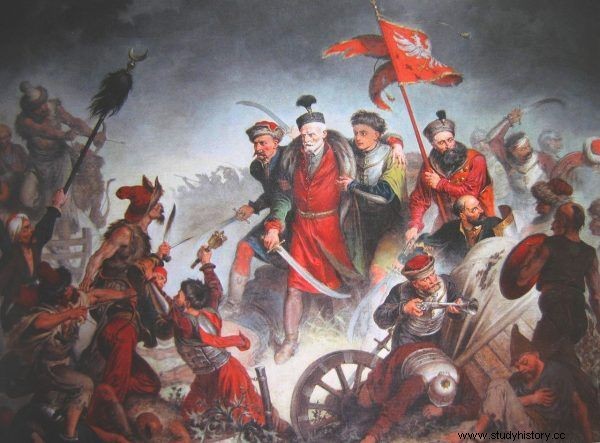
At Cecora in 1620, Żółkiewski's army suffered a disastrous defeat. The illustration shows the painting by Walery Eljasz-Radzikowski "Death of Stanisław Żółkiewski".
And by whose hands? Tatar-Turkish. How could this have happened? Why has this happened? In a nutshell, the answer is:because of the lack of discipline in the military and the promise to punish those who broke it.
Original sin - financing the army
The period of the reign of Sigismund III Vasa brought about a previously unknown phenomenon - the confederation of troops. The first was established in 1590. The next ones were established in 1597, 1602, 1603, 1605, 1606, 1609, 1612–1614. And so on. The reason was the arrears of the state treasury with the payment of due pay. A military confederation is an organized revocation of obedience. The army, instead of fighting, seized royal and religious goods and squeezed money out of them.
Another phenomenon, unknown before the reign of Sigismund III Vasa, were money stations, i.e. the fee for the stationing army. In other words, whenever a unit came to the quarters, it took money from its hosts.
Sometimes it was done extremely brutally - even kidnapping peasants' children and forcing their parents to buy their offspring. Both of these phenomena were therefore nothing more than organized plunder of the army, in addition, this practice was viewed through the fingers. It was tolerated because the pay from the state treasury was arriving either with a very long delay or in an incomplete amount.
However, this resulted in a drastic decrease in discipline in the army, which was difficult for the weaker hetman to restore. And this had negative repercussions in the face of enemy threat. It must be remembered that the hussars did not exist in a vacuum. What has been written about the plunder of the Polish army necessarily applies to this formation as well.
Accusations of the hussar comrades of looting were sporadic, but a very large and loose domestically allowed themselves to commit these offenses, which made up for them also for their masters (...). The comrades themselves were not saints either. Willing to at least partially make up for the expenses incurred, which the due pay did not compensate in any way, they plundered the enemy in convenient situations. So it also happened that when the hussars threw themselves at the prey in the already conquered enemy camp, the enemy strengthened and returned to the fight, to finally chase away the scattered company and wrest the victory from him.
And when the enemy does not want to fight in the open field ...
In 1621, the entire power of the Ottoman Empire fell to the Republic from the south. In the north, the young wolf Gustav Adolf takes this opportunity and with his Swedish army begins the siege of Riga. The raid was stopped in the south. The Hussars have their share in this:on September 7, 1621, they are famous for their charge that destroys an enemy fifteen times more numerous.
Things are worse in the North, however. Almost everything the country could do was sent against Turczyn. Only a handful of soldiers under the command of Krzysztof Radziwiłł remained to defend Livonia. The Swedes, beaten on a regular basis, have not been treated with the necessary seriousness. Kircholm's memory was still alive.
And here, on September 9, 1621, Radziwiłł appears with ... 900 soldiers near Riga, besieged by about 18,000 Swedes. 20:1 power disproportion in favor of the Swedes! But the Swedes have not forgotten about Kircholm either. Only a few hundred of them were found in the open field - these were smashed immediately, in which the hussars played a decisive role.
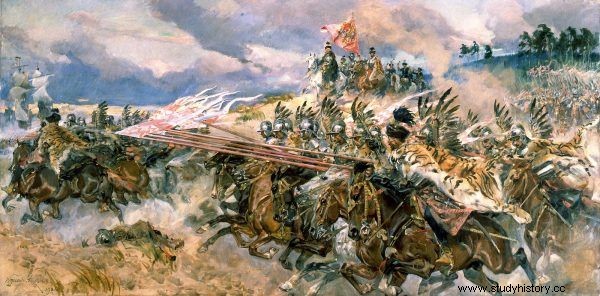
The Swedes have learned from the defeat at Kircholm.
The rest either hid behind the field fortifications or remained on the other side of the Daugava River. Radziwiłł waits for the enemy all night. This one is completely passive. So on September 10, she tries to lure him out into the open. After all, only there can hussars prove themselves! But the provocative attack of a small number of Lithuanian infantry on one of the Swedish blockhouses does not help.
The Swedes consistently do not stick their nose out of the fortifications. What to do? Radziwiłł withdraws the hungry and tired army from Riga. The Swedes beat off a great victory. And Riga, deprived of hope for relief, surrenders on September 25, 1621. With her, most of Livonia falls into the hands of the enemy.
The Commonwealth rubs its eyes with amazement, while Radziwiłł desperately defends his honor, proving that he is not to blame for it, but the new tactic of the Swedish army - the tactic of avoiding confrontation with his cavalry in the open field. So what if the hussars in the open field were second to none when you didn't have to fight this way?
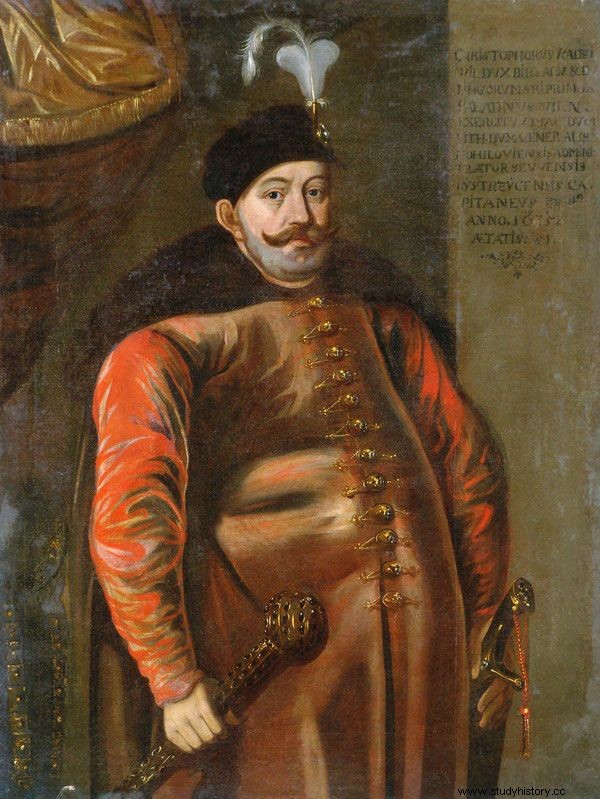
With only a few hundred soldiers under his command, Krzysztof Radziwiłł did not manage to save Riga. The Swedes did not intend to take part in a major battle.
Army of deputies
When reading the sources, the colossal importance attached to the role of commanders by the diarists is striking. When describing the battle, one could not mention the number of soldiers, but the death or wound of the commander was discussed very extensively. For the people of that era, what the captain did (colonel, queen) was of great value.
Captains were wealthy nobles, and in a later epoch, magnates. If the owner of a great fortune, a person holding considerable dignities in the state, a descendant of a well-known and meritorious family for the Republic of Poland, personally brought a banner to the camp and set his neck in battle, the lower-ranking officials saw the sense in it, and they did it too. When he put up a deputy (lieutenant), then such a lieutenant also looked for a deputy (governor), etc.
And when behind the beautiful façade of the defenders of the Republic of Poland, an army composed of deputies of these defenders was erected (comrades lavishly posted mails, captain and lieutenants, etc.), such an army was no longer of great value in battle. Because the post office was not beaten and he saw that since the more important than him avoided the "honor" of the fight, he also did not want to fight her (...).
Training
The fall of the hussars' training in the 18th century was dramatic (...). And while the tankmen still had the motivation to improve their skills, because they and the flags of light cavalry were sent every year to fight with haidamak bands, the hussars were deprived of even this stimulus.
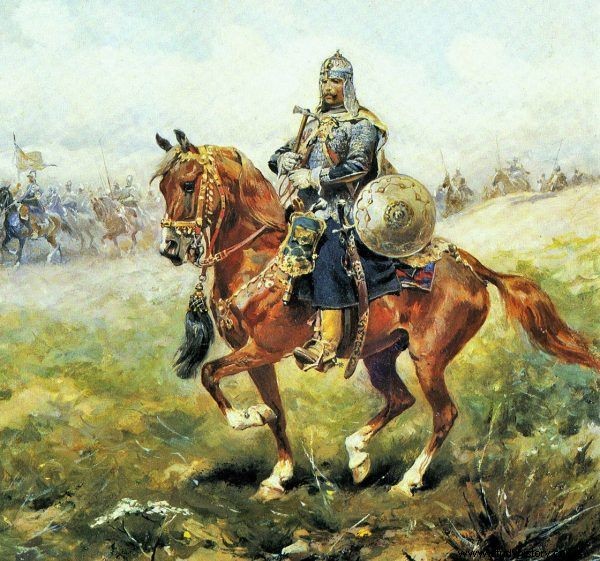
At the beginning of the 18th century, the tankmen continued to polish their skills on a regular basis. however, the hussars were less and less trained.
"Every man in our Republic" These words, put into the mouth of Sienkiewiczowski Kmicic, perfectly reflect one of the fundamental problems of Polish driving in the early 18th century. There were disputes within the command and reluctance to submit to the command of the superior (...).
This applied not only to comrades. It applied even more to their commanders. What this led to is shown by the most embarrassing defeat of the Old Polish driving. It happened near Warsaw on July 31, 1705.
Although only cavalry participated in the battle, and despite the three-fold superiority of the Saxon-Polish-Lithuanian cavalry over the Swedish one, the Swedes won the battle! This is due to the fact that Polish and Lithuanian commanders got into fierce disputes among themselves. These were not new problems, but their magnitude in the early eighteenth century exceeded anything that of the previous centuries.
Fall of morale and confidence
All these problems led to one thing - the collapse of the hussars' morale and self-confidence. And this could not have ended otherwise than with a drastic reduction in their combat value. Because the weapon itself and even the best fighting horses did not win (...). The fight was won by a man - confident, well-led, trained, experienced and disciplined.

What was the phenomenon of the deadly effectiveness of the best Polish driving you will learn from the book by Radosław Sikora “Husaria. The pride of Polish arms ”(Znak Horyzont 2018).
The tendencies unfavorable for the hussars accumulated at the beginning of the 18th century. During this period, the Republic of Poland was embroiled in the Northern War. The Polish army then encountered a Swedish soldier, whose confidence grew from battle to battle, because the Swedes, before entering Poland, fought the Danes, the Saxons and the Russians.
Staring at their charismatic King Charles XII, led from victory to victory, representing - just like the Polish army so far - an offensive style of combat in which striking white weapons dominated fire fighting, Swedish soldiers turned out to be the final nail in the coffin for morale Polish army. The first major battle between the Crown and Swedish troops, the Battle of Kliszów (July 19, 1702), showed the advantages of the troops of Charles XII and revealed the problems of the Polish troops.
The reconnaissance charge of about 260 Polish cavalrymen, half of whom were hussars, was stopped with obstacles - Spanish goats. After that, the commander of the Poles, Hieronim Lubomirski, ordered the entire army of about 3,000 soldiers to retreat from the battlefield. A maneuver completely incomprehensible from a military point of view.
No wonder then that one of the soldiers who witnessed these events wrote directly on the same day:"Our Poles escaped because the hetman [was] bribed from the Swedes." After this blow, the hussars did not get up anymore. Though it continued to exist for a few more decades, these were decades of stagnation and decline.
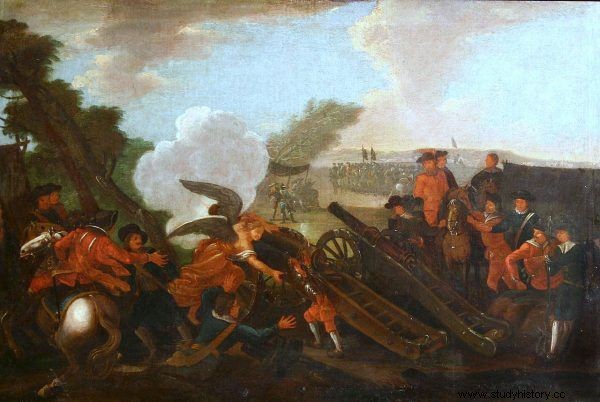
After the defeat at Kliszów, the hussars never rose again. The illustration shows an 18th-century battle painting.
Two Ages of Glory
Hussars existed in Poland for almost three centuries, the first two being the period of its glory and great combat deeds. Rarely any formation in the history of the world remained at the top for such a long time. The soldiers of Alexander the Great, Napoleon or the aforementioned Charles XII also had their great moments, but they lasted more or less ... two decades. Meanwhile - let us repeat - the hussars enjoyed spectacular success for two centuries. And since everything has its end, the time has come for this formation as well.
Despite everything, there is a small dissatisfaction and regret. It is a pity, because even in Napoleon's times the cavalry dressed in cuirasses was still very useful, and the cuirassiers themselves survived in Europe until the First World War. At that time, however, the glory and fame of the Polish copy of the hussars were taken over by the Polish uhlans.
Source:
The above text was originally published as part of the book by Radosław Sikora "Husaria. The pride of the Polish army ” (Horizon 2019 sign).
The title, lead, illustrations with captions, bolds and subtitles come from the editorial office. The text has undergone some basic editing to introduce more frequent breakdown of paragraphs.
